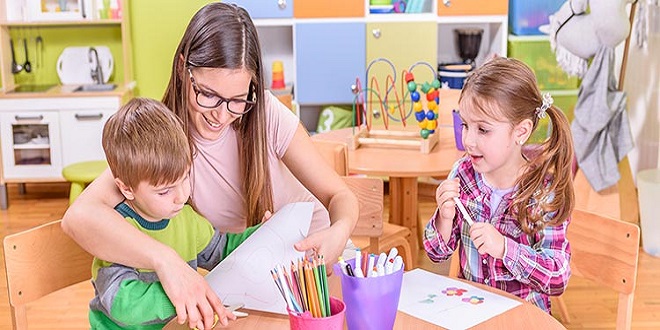7 Ways to Make Learning Fun for First Graders

Every educator understands the struggle of trying to fulfill their job requirements in a fun way for the students. There is a job to do in the classroom, after all, that is not always smooth sailing. First grade students are young and this is a natural barrier to learning engagement as the school environment is more tiring, and more strenuous for smaller minds. However, classrooms are still able to nurture the fun side of education while delivering the syllabus; it simply requires thinking outside of the box. Here are eight suggestions for making learning fun for first graders.
Class Writing
Writing is a fundamental skill that all students must acquire, but it isn’t easy and it certainly comes more naturally to some than others. A balance must be struck between ensuring progress while nurturing creativity and engagement, which can sometimes feel impossible. A problem in teaching fundamental skills to a large group of learners at this stage is that, as the absorption of knowledge happens at such a varied rate, teachers have to implement a different routine for almost every pupil. Here are some options for making this work.
Make it Fun
Writing doesn’t have to be just tracing letters and copying words down from the board. That is boring, objectionably, and is a road to failure when it comes to six and seven year olds. Online resources are a gold mine of motivational materials for teachers to use. For example, Studentreasures Publishing has an entire range of worksheets ready to download and start using to encourage writing skills along in a more engaging platform.
Be Vigilant
The students who struggle will naturally fall behind, and with groups of large students, they are easy to miss. These students may mask their inabilities out of embarrassment, and they may never ask for help. Regularly observed classwork enables educators to keep a closer eye on progress and frequent walks around the classroom, touching base with each young learner will help to ensure that those who may need a little more help, get what they need to succeed.
Amalgamate Skill Acquisition
Writing is used across all subjects once mastered, but first graders will not be fluent writers just yet. They have a few years of handwriting roadblocks to master, spelling, and grammar to learn, and it is fairly common for letters to be formed incorrectly here and there still at this stage. So, for a focus on writing, consider mixing up the lesson style by integrating with an art focus, for example. Create a storyboard, either in groups or as an individual. This presents an opportunity for drawing and art skills to be explored as well, and create a whole story project that is exciting. It also nurtures autonomous learning.
Learn Through Play
Imagination is one of the most valuable tools in education for younger learners. If you can tap into the creative process through inspiring the imaginative play cognitive function, it has been shown time and time again that this is a guaranteed method of enhancing education progress. Role play teaches essential social skills but can have a teaching focus too. Setting up a class shop, for example, can teach math skills (addition, subtraction) reading and spelling (labeling products, reading out product names), drawing and creation (making products/shop features), and social etiquette (how to navigate a store style situation). Other skills such as turn-taking, learning to share, and collaboration or advocation are also natural consequences of this style of teaching.
Sing
Sing and dance! Music is a proven successful learning tool and can be applied in any lesson. Why do you think the alphabet is mainly taught in song form? Because it sticks! Music also acts as a mood booster by allowing the brain to get that endorphin ball rolling, which is a natural way to boost participation.
Class Reading
Reading books is not always appealing to younger students, especially those just starting to learn. Processing the words can be difficult, and following the story as it moves along requires levels of concentration that aren’t always available to small children. Yet, it is the teacher’s job to engage them because reading has immeasurable benefits for learners – so how can this be achieved? And, more importantly, how can it be made fun? There are several routes worth exploring.
Firstly, try turning a popular story into a play and give everyone a part. Narrators can read lines of narrative and actors’ lines of dialogue. That way, reading is still happening and stories are being absorbed but in a more active style of learning that is far more contingent on successful learning for this age range.
Secondly, let the children choose what to read. Giving choices is integral to positive educational experiences, as it validates emotions, and encourages autonomy and self-assertion in a healthy and safe arena.
Thirdly, keep it short! Make a book the focus of the week and base lessons around it. Snippets of reading such as a couple of pages here and there are easier to digest mentally than expecting a whole book to be read in one session.
Give Them Choices
Authoritarian classrooms are things of the past. Teachers, of course, have to instil a level of discipline in their students, but the focus has shifted onto something much more nurturing. This has been an essential change for protecting the emotional development of children generally, but younger children especially. Choices in learning enable empowerment. The best way to learn is by taking ownership and understanding what kind of studying works for you while also acknowledging what does not work for you. When someone feels empowered, they are automatically better motivated to engage with the task at hand.
So, by offering choices in school, children’s confidence can grow and they feel more in control of their learning journey. A miserable child will not be able to excel in their studies, but one that is emboldened through choices will. These choices don’t have to be complex, it can be as simple as which color writing book would you like? Or even, would you like to do addition or subtraction today?
Incorporate Movement and Outdoors Time
Let the children move. It really is that simple. Kids were never meant to sit still, as it goes against their natural functions. Make sure there is space in every school day for free movement time, and play outdoors. Acknowledge that sitting still at a desk or a mat is all but impossible for certain children and never enforce this all day long. Outdoor learning is a health boost, encourages a more active lifestyle generally, and takes the learning focus outside of the four walls of the classroom.
Arts and Crafts – Always
Finally, give the kids time to explore arts and crafts materials. It is likely that at this age, art skills are still being established. Making pictures is fun, and it can be incorporated into the wider learning objective easily. Drawing and painting teach essential dexterity skills, coordination, concentration, and idea generation in an experimental manner.
Freestyle expressive sessions with an arty focus are a brilliant way to break up the school day. Even if things get a little messy, that’s okay, it’s all a part of the fun. It also teaches them how to tidy up and take responsibility.
Learning can be fun, and it should be especially for young learners in the first grade. These are some of their fundamental first experiences in school and some students will already be disenchanted, unfortunately, at this early stage.





